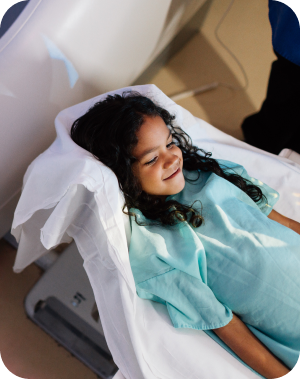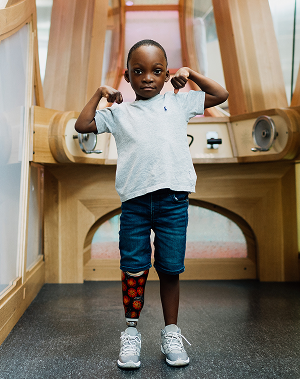crouzon


about condition
Crouzon syndrome is a genetic congenital condition characterized by skeletal and facial malformations. Severity of the syndrome varies from mild to severe among individuals. A key feature of Crouzon is the premature closure of the skull bones, called craniosynostosis. This means premature fusion of the fibrous joints (called sutures) between certain bones of the skull are what prevent the head from growing as it should, and may affect other facial bones as well. This fusion of sutures can affect bones that form the forehead, the upper sides of the skull and in some cases, even the back and side of the skull. Typically, craniosynostosis from affected children with this syndrome begins during the first year of life and progresses until age two to three, approximately. In some cases, it will be obvious at birth but in rare cases it may not be apparent until late childhood. In most individuals, early suture fusion causes the head to appear unusually short and broad. In some, the head may appear long and narrow, while in others, triangle in shape. In individuals with Crouzon syndrome, intelligence is usually not affected.
Characteristics of this syndrome may include:
- Skull bone malformations (craniosynostosis)
- Short and broad head (different head shape in some cases)
- Possible abnormal fluid accumulation in cavities of the brain (hydrocephalus)
- Prominent forehead
- Shallow eye orbits (bone that supports the eyes)
- Protruding/bulging eyes (proptosis)
- Widely spaced eyes (hypertelorism), eyes that cross or point in different directions (strabismus)
- Eye issue that leads to lazy eye (amblyopia)
- Curved nose
- Possible sensorineural hearing loss
- Flat or underdeveloped midface area (midface hypoplasia)
- Possible small underdeveloped upper jaw (hypoplastic maxilla) and protrusion of lower jaw as a result
- Short upper lip
- Rare clefting of the lip and/or palate
- Dental issues, such as: high arched narrow palate, crowded teeth, upper and lower teeth don’t meet (malocclusion)
- Possible upper airway breathing issues (may need surgical intervention)
*Surgical intervention may include cranial vault and midface distraction procedures to improve functions early on, as well as other necessary procedures
how do I know if my child will be born with this condition?
Sometimes when an ultrasound is performed during pregnancy, a doctor may notice non-typical signs which require additional testing. More in-depth testing with 2D or 3D ultrasounds or a fetal MRI can reveal much more. After birth, clinical examinations, CT scans, MRI, and other testing can help to diagnose the syndrome. (In some cases it is not diagnosed until later in childhood.) If an affected parent is known, during the pregnancy, more in-depth testing can be done earlier to help rule out the syndrome. If the mutation change location is known for an affected parent, genetic testing can be done for the fetus since any positive mutation will be in the same location, as it will be for any family member. Genetic counseling is highly recommended for any individual with Crouzon syndrome having or considering a future family.


how do you treat Crouzon syndrome?
The treatment of Crouzon is focused on the specific symptoms apparent in each individual since the symptoms can vary widely. Several specialties and physicians may be involved throughout the child’s life. Early surgeries may include craniofacial and reconstructive procedures to correct skull and head malformations to allow the brain to grow and develop properly. Also, there may be possible surgery to relieve any intracranial pressure. Patients may see some or all of the following physician specialties: pediatrician, neurologist/neurosurgeon, geneticist/genetic counselor, ophthalmologist, otolaryngologist (ENT), audiologist, dentist, orthodontist, oral surgeon, social worker and other healthcare professionals.
faqs
Crouzon syndrome affects an estimated 1.6 of every 100,000 births. It affects both males and females; however, research indicates that males are affected more than females.
Yes, this is a genetic craniofacial condition that babies are born with, although, it may not be readily apparent at birth. Crouzon syndrome occurs in an autosomal dominant fashion; it can be inherited from a parent or happen as a first-time occurrence. The majority of individuals with Crouzon have a spontaneous new mutation change in the gene; simply put, the mutation change alters the gene for the syndrome to occur but the reason is not known. Other individuals inherit the condition from an affected parent. Once an individual has the syndrome, there is always a 50% chance of passing it on to future children.
Even though surgeries may often be in their future, individuals with this syndrome can have a typical life span.
The involvement for this syndrome is one of the FGFR genes, usually FGFR2. (This gene is also known for causing similar syndromes, such as: Apert, Pfeiffer and Jackson-Weiss syndromes.)
The gene that causes Crouzon syndrome to occur plays an important and critical role in skeletal development. Genes give instructions for creating the proteins that play vital roles in our body. When a mutation change in a gene happens, the protein that is important for building structures is disrupted. When a genetic change happens in FGFR2, it results in these receptors not communicating properly with fibroblast growth factors. This will create craniofacial malformations.
- Craniofacial dysostosis
- Craniostenosis, Crouzon type
- Crouzon craniofacial dysostosis
Syndromes that are similar and/or related with Crouzon:
- Apert syndrome
- Pfeiffer syndrome
- Jackson-Weiss syndrome
- Saethre-Chotzen syndrome
here when you need us
Whether you’re looking for the right provider, ready to make an appointment, or need care right now—we’re here to help you take the next step with confidence.
